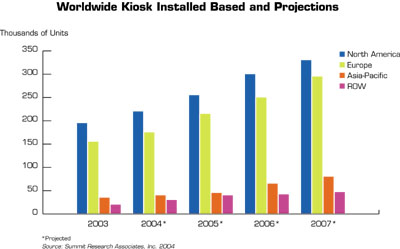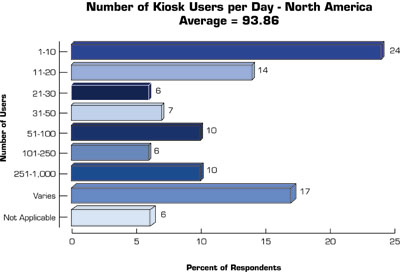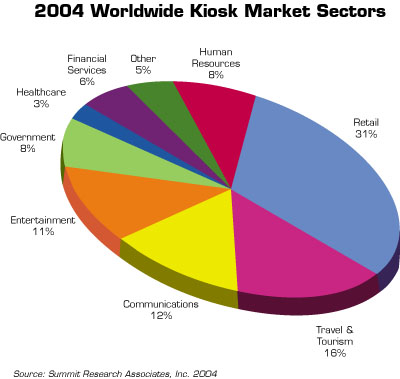News
Stats + Facts Mar/Apr 2004
April 25, 2005
Kiosk programs happening, but hurdles abound
New analysis from Frost & Sullivan's World Interactive Kiosks Market report released in February foresees that revenue in this market will reach $801.5 million by 2010. "The diverse parameters of different departments' success also have to be factored into the ROI analysis," says Frost & Sullivan Industry Analyst Vineeta Kommineni. "Marketing departments usually demand an immediate ROI, while IT and Operations departments may define metrics as recoupment of their investment over medium to long term."
With most clients adopting a conservative approach to IT investments and funds being scarce, a distinct plan is vital for project commissioning. However, with well-orchestrated publicity of successful kiosk projects and redefinition of ROI by vendors, Frost & Sullivan predicts the impact of this restraint to decline. "The success of a kiosk project depends on the smooth interaction among enclosure manufacturers, software firms, hardware component vendors, integrators, and maintenance service providers. These individual suppliers often sell 'products' rather than complete solutions," the company said in a statement.
At the client's end, personnel takes the decision to commission a kiosk project at different hierarchies in divisions such as IT, marketing, operations, and top management noted Frost. "Such dispersed decision-making leads to significant delay at the customers' end, effectively hindering sales cycle, which currently ranges from 3-4 months for a pilot and 14-18 months for a full rollout," said Kommineni.
Retailers to increase spending on technology
Retailers will participate in the surge of business spending expected this year, according to new research by the NRF Foundation (NRFF) and BearingPoint, Inc. unveiled mid-January. The study, "Retail Horizons: Benchmarks for 2003, Forecast for 2004," found that eighty-three percent of retailers expect replacing or upgrading point of sale (POS) software systems to provide real-time customer information at the time of sale. This second annual study, which surveyed more than 100 retailers, focuses on store and field operations, supply chain, customer relationship management, merchandising, advertising, human capital, information technology and marketing issues.
In analyzing this year's survey data, NRFF and BearingPoint observed that the three currents of change of last year - moving toward greater customer-centricity, traveling along the data-knowledge-action continuum and shifting toward a boundaryless business model - were reaffirmed with the addition of a fourth current: the need for retailers to be on a greatly accelerated path to differentiate themselves from the competition.
The study suggests several approaches retailers can use to differentiate themselves from the competition, including:
- Leveraging a robust understanding of the consumer to create unique, differentiated merchandise assortments.
- Build a brand in an integrated way that resonates.
- Provide a seamless, multi-channel shopping environment.
- Build and sustain a high performance workforce.
www.bearingpoint.com
www.nrf.com
Fifth edition kiosk report
Summit Research Associates has released the new Fifth Edition of their flagship report, Kiosks and Internet Technology. This report - the most comprehensive ever produced on the kiosk industry - examines recent trends, provides projections for the kiosk installed base, CAGR and revenues from the present time through 2007. The report also includes 35 charts and tables on the leading kiosk issues and examines the industry from many perspectives, including: the average number of users per day (see chart), average revenue per day, average length of time spent at the kiosk, leading design issues, leading types of peripherals used, most popular kiosk applications and lessons learned.
KIOSK magazine had the opportunity to speak with head analyst Francis Mendelsohn at Summit about the changing landscape of internet access terminals. Although the outlook remains positive for some systems, the once projected number of units has changed due to competitive technologies. Mendelsohn said that the pay-per-use internet access terminal is at about 10%, and possible as low as 5 percent, of the entire kiosk market. "I don't think the overall growth will ever amount to what was once forecast (because) there are too many technological competitors - WiFi for sure-both in PCs and phones/PDAs," noted Mendelsohn. In addition, she pointed out that many hotels are now throwing in free high-speed Internet access, "so why would one really need to use the Web Payphone at all?" Where they continue to shine, she said, is in bill payment. Combining a Web Payphone with a bill payment unit Mendelsohn believes will continue to be a winning terminal.
The report, available as a PDF or CD-ROM, sells for $1,395.00 (USD), including U.S. shipping and handling. KIOSK magazine has secured for our readers a special offer to receive the report for $1,095.00. As an additional incentive, if you order the report by March 15 you will receive an Excel spreadsheet containing all of the Company Profile information.
 |
 |
 |
Retail and foodservice ripe for kiosk technology
"As retailers and restaurants across the country prepare to go on a technology spending spree, vendors and competitors are hungry for information about the major players and their existing IT systems," said IHL Consulting Group, a leading retail consultancy. "Retailers' technology systems overall are aging significantly, but most companies have been waiting for an improvement in the economy before investing in new equipment," said Greg Buzek, president of IHL Consulting Group, an analyst who serves retailers and retail technology vendors. "We are on the verge of an impressive buying cycle. And the vendors and competitors who have the greatest insight into major players' businesses are the ones who stand to gain the most."
The National Restaurant Association (NRA) has put kiosk technology high up on it's list. It's 2004 NRA Show in Chicago this May plans to show the latest and greatest in kiosk technology and has even been using pictures of self-service kiosks to build awareness for the show. The NRA has found that 70 percent of adults age 18-34 would use self-serve terminals to place orders at a drive-thru if given the option, and they feel the "kiosk timing" is right since 41 percent of QSR operators plan to allocate a larger proportion of their budget to technology in 2004. "As one of the nation's most labor-intensive industries, restaurants are constantly looking to integrate new technologies into their businesses," said Mary Pat Heftman, senior vice president of the NRA convention. "We are very excited about kiosk technology and how it will help the restaurants."
http://www.ihlservices.com/
www.restaurant.org/show
Originally published in the Mar/Apr 2004 issue ofKiosk magazine.







